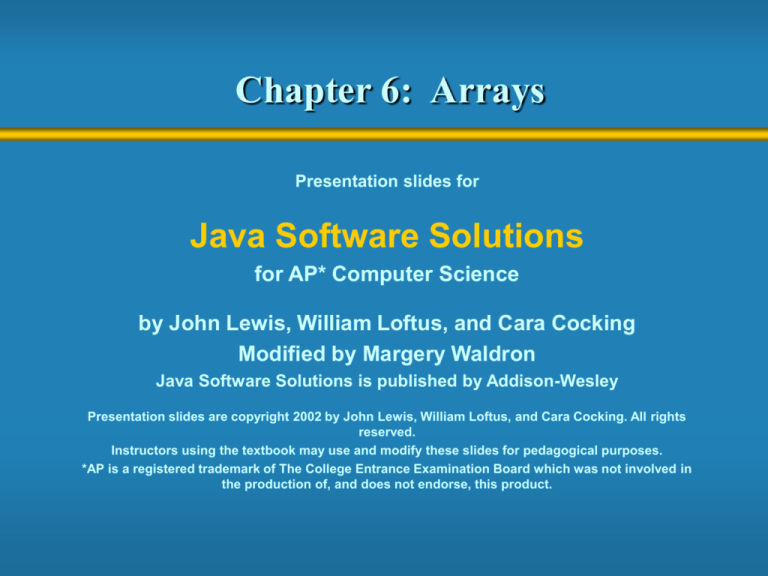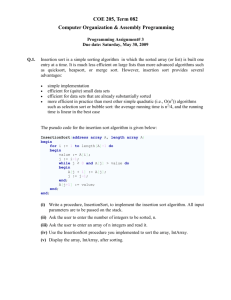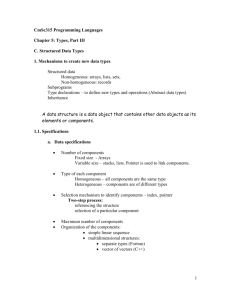
Chapter 6: Arrays
Presentation slides for
Java Software Solutions
for AP* Computer Science
by John Lewis, William Loftus, and Cara Cocking
Modified by Margery Waldron
Java Software Solutions is published by Addison-Wesley
Presentation slides are copyright 2002 by John Lewis, William Loftus, and Cara Cocking. All rights
reserved.
Instructors using the textbook may use and modify these slides for pedagogical purposes.
*AP is a registered trademark of The College Entrance Examination Board which was not involved in
the production of, and does not endorse, this product.
Arrays
Arrays are objects that help us organize large
amounts of information
This lesson will focus on:
•
•
•
•
•
array declaration and use
passing arrays and array elements as parameters
arrays of objects
searching an array
sorting elements in an array
2
Arrays
An array is an ordered list of values
Each value has a numeric index
The entire array
has a single name
0
scores
1
2
3
4
5
6
7
8
9
79 87 94 82 67 98 87 81 74 91
An array of size N is indexed from zero to N-1
This array holds 10 values that are indexed from 0 to 9
3
Declaring Arrays
Some examples of array declarations:
double[] prices = new double[500];
boolean[] flags;
flags = new boolean[20];
char[] codes = new char[1750];
4
Arrays of Objects
The elements of an array can be object references
The following declaration reserves space to store 25
references to String objects
String[] words = new String[25];
It does NOT create the String objects themselves
Each object stored in an array must be instantiated
separately
See GradeRange.java (page 310)
5
Arrays of Objects
Objects can have arrays as instance variables
Many useful structures can be created with arrays
and objects
The software designer must determine carefully an
organization of data and objects that makes sense
for the situation
See Tunes Project (page 312)
6
Searching
A common task when working with arrays is to
search an array for a particular element
A linear or sequential search examines each element
of the array in turn until the desired element is found
A binary search is more efficient than a linear search
but it can only be performed on an ordered list
A binary search examines the middle element and
moves left if the desired element is less than the
middle, and right if the desired element is greater
This process repeats until the desired element is
found
See Searches.java (page 319)
7
Sorting
Sorting is the process of arranging a list of items in a
particular order
The sorting process is based on specific value(s)
• sorting a list of test scores in ascending numeric order
• sorting a list of people alphabetically by last name
There are many algorithms for sorting a list of items
These algorithms vary in efficiency
We will examine two specific algorithms:
• Selection Sort
• Insertion Sort
8
Selection Sort
The approach of Selection Sort:
• select a value and put it in its final place into the list
• repeat for all other values
In more detail:
• find the smallest value in the list
• switch it with the value in the first position
• find the next smallest value in the list
• switch it with the value in the second position
• repeat until all values are in their proper places
9
Selection Sort
An example:
original:
smallest is
smallest is
smallest is
smallest is
1:
2:
3:
6:
3
1
1
1
1
9
9
2
2
2
6
6
6
3
3
1
3
3
6
6
2
2
9
9
9
See SortGrades (page 323)
10
Swapping
Swapping is the process of exchanging two values
Swapping requires three assignment statements
temp = first;
first = second;
second = temp;
11
Insertion Sort
The approach of Insertion Sort:
• pick any item and insert it into its proper place in a sorted
sublist
• repeat until all items have been inserted
In more detail:
• consider the first item to be a sorted sublist (of one item)
• insert the second item into the sorted sublist, shifting the
first item as needed to make room to insert the new addition
• insert the third item into the sorted sublist (of two items),
shifting items as necessary
• repeat until all values are inserted into their proper positions
12
Insertion Sort
An example:
original:
insert 9:
insert 6:
insert 1:
insert 2:
3
3
3
1
1
9
9
6
3
2
6
6
9
6
3
1
1
1
9
6
2
2
2
2
9
See SortGrades2 (page 324) -- the insertionSort
method
13
Sorting Objects
Integers have an inherent order, but the ordering
criteria of a collection of objects must be defined
Recall that a Java interface can be used as a type
name and guarantees that a particular class
implements particular methods
We can use the Comparable interface and the
compareTo method to develop a generic sort for a set
of objects
See SortPhoneLists (page 328)
14
Comparing Sorts
Time efficiency refers to how long it takes an
algorithm to run
Space efficiency refers to the amount of space an
algorithm uses
Algorithms are compared to each other by
expressing their efficiency in big-oh notation
An efficiency of O(n) is better than O(n2), where n
refers to the size of the input
Time efficiency O(2n) means that as the size of the
input increases, the running time increases
exponentially
15
Comparing Sorts
Both Selection and Insertion sorts are similar in
efficiency
They both have outer loops that scan all elements,
and inner loops that compare the value of the outer
loop with almost all values in the list
Approximately n2 number of comparisons are made
to sort a list of size n
We therefore say that these sorts have efficiency
O(n2), or are of order n2
Other sorts are more efficient: O(n log2 n)
16







